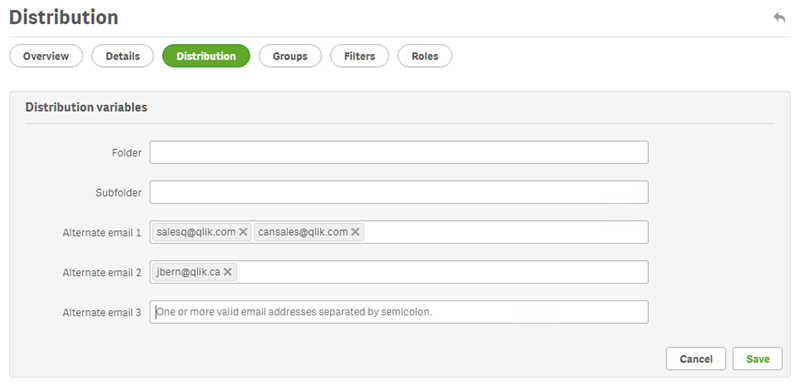Creating users
You have to add and configure users before you can send them reports. You can add users manually, or import them.
For more information on importing users, see: Importing users.
Administering new users
You must have sufficient admin rights to view, edit, create, or delete users. You can do the following once you have created users:
- Configure delivery and filtering information.
- Manage distribution groups. Users will automatically receive reports if they belong to a distribution group associated with a publish task.
- Activate and de-activate user accounts. Users who are de-activated will not receive reports, even though they may be associated with a publish task.
- Set security information including roles, passwords, and link to a domain account.
- Define a locale and a time zone that is specific for each user.
Creating a new user manually
Do the following:
- From the Admin menu, click Users.
- Click Create user.
Configuring user identity
Do the following:
- Configure the following fields in the Overview tab:
- Email: Enter a unique and valid email address that the user will use to log on.
-
Name: Enter an identifier for the user that will be used in Qlik NPrinting. For example, you will see the list of user names when you add a user to a Publish task.
-
Password: Enter a password. Password strength is displayed under the field. The border will be red if the password is not complex enough. This is for information purposes only, and will not stop the user creation process.
Valid password characters are letters, numbers, and the following special characters: $ & + , : ; = ? @ # | ' < > . - ^ * ( ) % !
- Confirm password: Enter the password again.
- Domain account: Enter the domain and user name if you want to associate the user with a domain account.
A user must have an associated domain account to use the following features:
- Receive reports in Qlik Sense hub.
Create On-Demand reports in QlikView.
The user's Windows Active Directory user account must be associated as the domain account.
-
Time zone: Select a time zone for the user. The scheduled subscriptions for the user will be run according to the time zone.
-
Locale: Select a locale for the user. This sets the user interface language for Qlik NPrinting web console, NewsStand, and Qlik NPrinting Designer.
-
Enabled: Deselect the check box it if you want to save the user but keep the account inactive.
- Report security: These passwords are used to view and edit encrypted reports. Enter a Password to open, a Password to write, or both (optional).
- Click Create.
The Details, Groups, Filters and Roles tabs become enabled.
Configuring user details
Do the following:
- Configure the following fields in the Details tab. All these fields may be used in HTML email messages. They can be set manually, or imported using Import task:
- Nickname
- Title
- Company
- Job Title
- Department
- Office
- Click Save.
Configuring report distribution
Do the following:
- Configure the following fields in the Distribution tab.These fields determine where reports are sent. They can be set manually, or imported via Excel.
- Folder: Enter the path to a distribution folder where the user can find their reports (optional).
- Subfolder: Enter the name for a subfolder (optional). It can be combined with a manually typed.
- Alternate email 1: Enter alternate email addresses, separate by semicolons (optional). These could be used for To, CC, or BBC fields.
- Alternate email 2: Enter alternate email addresses, separate by semicolons (optional). These could be used for To, CC, or BBC fields.
- Alternate email 3: Enter alternate email addresses, separate by semicolons (optional). These could be used for To, CC, or BBC fields.
- Click Save.

Configuring user groups
You can add the user to one or more groups.
Do the following:
- From the User menu, click the Groups tab.
-
Select one or more groups from the list in the Available items column.
- Move the groups into the Selected items column.
- Click Update user groups to save your selections.
You cannot create new user groups from this page. To create new user groups, go to the Admin menu and click Groups.
Creating new groups
Groups are lists of users. You can put users who need to receive the same reports into a group. One user can be a member of many groups.
Reports received by users in the same group are based on the same templates. The data received by any particular user is based on the filters applied to that user.
Do the following:
- Select Admin in the main menu.
- Click Groups.
- Click Create group.
- Enter a name for the group.
- Enter a description (optional).
-
Select users in Available items.
- Select one or more users from the list in the Available items column.
- Move the users into the Selected items column.
- Click Create to save.
Setting user filters
You can add filters to users manually. All reports sent to them will have data filtered accordingly.
Do the following:
- From the User menu, click the Filters tab.
- Select the filter you want to add, then click > to move it from the Available items to the Selected items list.
You can use Shift or Ctrl to make multiple selections.
- Click Update user filters to save your selections.
Defining user roles
Roles define the rights of users. You have to assign one or more roles to each user.
Do the following:
- From the User menu click the Roles tab.
-
Select one or more roles in the Available items column.
- Move the roles into the Selected items column.
- Click Update user roles to save your selections.
